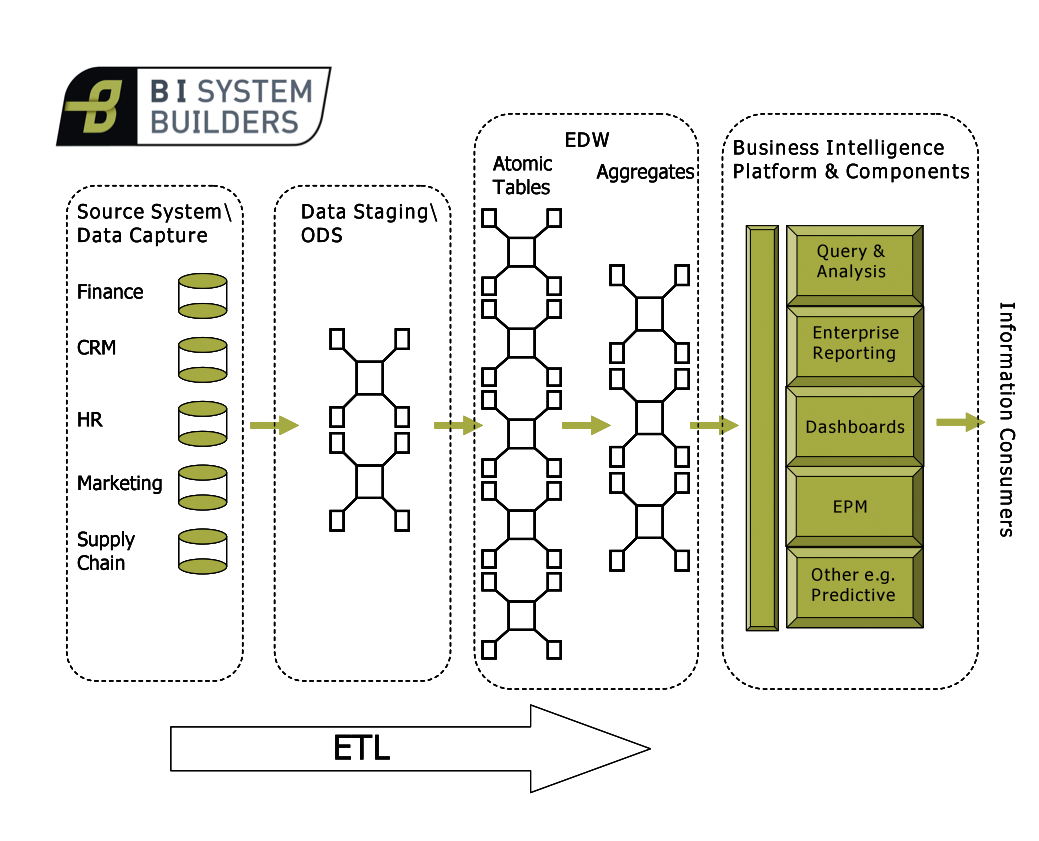We are asked many questions relating to the BI System Builders Cornerstone Solutions® and here are the answers to some of them.
What is a Cornerstone Solution®?
A Cornerstone Solution® is an End to End best practice framework for Business Intelligence and Data Warehousing. It has been developed by BI System Builders Ltd. It has two key components. The first is comprehensive Solution Architecture and the second is a delivery model that incorporates detailed project planning. It is designed to facilitate a set of Business Intelligence services to be brought together in a BI methodology that results in measurable deliverables, mitigating risk, and maximising project success. It can be thought of as a strategic framework for BI Architecture and Delivery.
Is it just for SAP BW systems or can it be used on other platforms?
A Cornerstone Solution® is vendor agnostic. It is not reliant upon any specific technology and is fully configurable. BI System Builders have expertise with SAP BusinessObjects and its connectivity into SAP BW and performance and historically, have partnered with the vendor SAP. However, SAP BusinessObjects is a technology, a BI Platform, BI tools and Data Integration capabilities. A Cornerstone Solution® is not tied to a specific platform such as Netweaver, a data integration tool, or any software vendor for that matter.
Is your method only relevant for SAP BusinessObjects technology, we want to use a different BI software vendor?
A Cornerstone Solution® is not software vendor specific. A Cornerstone Solution® is a generic end to end Business Intelligence framework rather than a SAP BusinessObjects method. It exists to deliver world class Business Intelligence and Data Warehousing solutions. We have referred to SAP BusinessObjects frequently because it’s a powerful BI platform and it’s also historically where a lot of our core technical expertise lies. However, if SAP BusinessObjects was not the technology of choice it would not matter, a Cornerstone Solution®could and has been applied to other technologies\vendors.
Is a Cornerstone Solution® applicable to Big Data?
Yes, a Cornerstone Solution® includes thinking about data governance, data quality and data integration as well as architecture, process and analytics. It would be no problem to incorporate capabilities such as learning models into the Cornerstone Solution® framework and massive amounts of data require more governance not less.
When Russell Beech was employed by BusinessObjects he co-authored a white paper entitled ‘The Rules of Engagement’, is a Cornerstone Solution® not just a re-hash of that?
No, a Cornerstone Solution® is much more than anything that the ‘Rules of Engagement’ could attain to. The ‘Rules of Engagement’ was written specifically to help Professional Services (BusinessObjects field consultants) implement the BusinessObjects Analytical Applications successfully on large scale deployments. It was based on experience of troubleshooting complex implementations in large organisations but a Cornerstone Solution® is much more. A Cornerstone Solution® is a complete End to End BI strategic framework that includes architecture, process and governance. The philosophy is essentially to architect and to plan so as to avoid problems rather than to let them grow to the point where troubleshooting is necessary.
Does a Cornerstone Solution® include ETL?
Yes it’s designed to deliver an End to End BI solution and data integration is a critical component. The Cornerstone Solution® considers everything from business analysis and requirements to source system data. Intrinsic to the solution is the ETL system itself.
Why do you say that Business Analytics are the end game of a Cornerstone Solution®?
A Cornerstone Solution® will help your BI project run smoothly. However, it can do far more than that. The full purpose of the Cornerstone Solution® is to use BI to help an organisation grow, increase profitability, gain competitive advantage, and increase efficiency and effectiveness. Business Analytics provide key information to business users helping them to achieve their purpose. A Cornerstone Solution® actually starts with corporate strategy and objectives. It is the cognizance of these that drives the BI Architectural decisions. Raw data has relatively low value unless it can be turned into usable information. The BIDW architecture must fully support this and the information is usually consumed through some form of analytic.
Where did the term ‘BI Breakpoints’ come from?
A career as a BusinessObjects consultant often leads to facing challenges. As consultants become more senior and experienced they are invited to troubleshoot the harder problems. We have seen many of these harder problems. The term was coined by us to describe the problems or failures in the BI system. These failures can include everything from physical components such as faulty software installs to activities such as ineffective requirements gathering leading to data models that are not fit for purpose. Understanding BI Breakpoints and pre-empting where they are likely to occur is core to implementing a Cornerstone Solution®.
If it’s a delivery methodology why do you say that BI strategy is also a component?
A Cornerstone Solution® has a defined framework. The application of some of the Business Intelligence services within the framework leads directly to tangible deliverables e.g. developing ETL code. The development of code is a tactical manoeuvre within the big picture. However, the framework itself is part of a still bigger picture, that of BI strategy. Formulating the BI strategy is critical to getting the tactics right for successful delivery. So a Cornerstone Solution® is a strategic BI framework rather than just a delivery method alone.
How is the Cornerstone Solution® different to what other BI companies do?
Perhaps other companies do exactly what we do? It’s possible. But it seems evident that many BI projects get into trouble. If a Cornerstone Solution® framework was being applied we believe that there would be less project difficulties.
What do you mean by ‘Cornerstone’ and why do you say that it’s a solution?
A cornerstone is the stone that forms the base of a corner of a building that joins two walls. It is the first stone to be laid down and on which everything else is built. The cornerstone in a successful Business Intelligence system/solution is the Business Intelligence framework. In a Cornerstone Solution® everything is built out from this framework. Solutions are ‘acts’ or ‘ways’ to answer problems. Cornerstone Solutions® are a framework facilitating a set of Business Intelligence services to be applied to help the organisation solve its business problems through best use of its Business Intelligence system.
How is a Cornerstone Solution® different to just program or project management?
A Cornerstone Solution® includes comprehensive project management and a good project manager is critical. However a Cornerstone Solution® includes BI strategy, a defined framework, and predefined matrixes, templates, and artefacts. The customer may often provide the program management with our support.
If you write about Cornerstone Solutions® other consultancies will just steal your ideas?
It’s often said that “imitation is the sincerest form of flattery”. We put many helpful things on our website at bisystembuilders.com and are fully aware of what we are doing. We like to give things away and will publish more and more. But reading about something and talking about something does not necessarily imply the knowhow of how to actually do it. The name Cornerstone Solution® is a registered trademark.
Can the Cornerstone Solution® work for a small company?
Yes, absolutely yes, and cost effectively too. A Cornerstone Solution® is scalable. It includes everything required for a big undertaking but some components are superfluous to small projects. The Cornerstone Solution® is designed in a modular fashion enabling us to strip out unnecessary components but leave the End to End BI view intact. Smaller companies only pay for what they need; they do not pay for unnecessary ‘nice to haves’.
Can BI System Builders help us with small parts of our BI project or do you only do full BI implementations using a Cornerstone Solution®?
BI System Builders can help you with small parts of your project. A Cornerstone Solution® is modular and we select the best practice part that is applicable to what you want us to do for you.
I’m new to Business Intelligence and some of the things that you talk about with Cornerstone Solutions® seem complex. Where can I read more about BI
You can read more at bisystembuilders.com and we plan to add lots of other content too. For an informed read on Business Intelligence we also thoroughly recommend the book e-business Intelligence authored by Bernard Liautaud the founder of BusinessObjects. It was published back in 2001 but is still very useful.
This is not really about Cornerstone Solutions® but what does the BI System Builders logo represent?
Actually it does relate to Cornerstone Solutions®. The logo is in the shape of the end of a large key. A key in itself is a solution to unlock something. You’ll notice that there is also a flow through the key. This is symbolic of the flow of data into information through your business… through your BI system. BI System Builders have the key that unlocks the flow. The key is a Cornerstone Solution®.
Why do you say that a BI project doesn’t need to be like a walk through a jungle when you talk about a Cornerstone Solution®?
Walk through the jungle with no map and no guide – not a good idea, it’s a big place and easy to get lost and end up in trouble. You know you could get caught out by things that you failed to see or expect, you could become disorientated, lose energy, and lose spirit. So you could consider one of the following:
- a) Employ a guide but take no map – if you have a good guide then you don’t need a map. However, you are trusting the guide to be who he claimed to be, but what if he’s not authentic? On the journey how will you know if you’re getting lost? When you’re really lost and come to the conclusion that you’re following a charlatan!
- b) Take a map but no guide – it’s possible, but anyone embarking on that journey should also take a compass and be sure that they can use them both effectively together, as well as knowing the jungle dangers and having wilderness experience.
- c) Take a map and a recommended guide – you get the best of both worlds. The guide can keep you safe and at the same time show you exactly where you are on the map so that you can check progress.
If BI System Builders is like a recommended guide, then a Cornerstone Solution® is like a map. You can know where you have come from, where you are, where you are going and where you will end up, safely!




You must be logged in to post a comment.